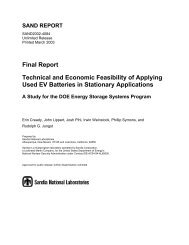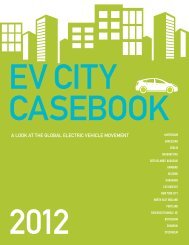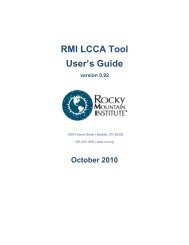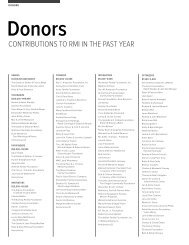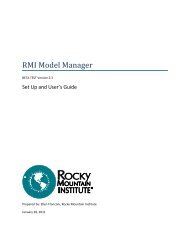Fleet Electrification Roadmap
Fleet Electrification Roadmap
Fleet Electrification Roadmap
- No tags were found...
Create successful ePaper yourself
Turn your PDF publications into a flip-book with our unique Google optimized e-Paper software.
96 part three: identifying fleet opportunitiesfleet electrification roadmap 97ABSTRACTPart One of this <strong>Roadmap</strong> outlined how and why commercialand government fleet owners could represent an importantearly market segment for grid-enabled vehicles. Part Twodiscussed several challenges that may need to be addressedthrough policy support and adjustments to the operationalnorms of fleet operators. Part Three presents the results oftotal cost modeling conducted for fleets in various industriesand sectors of the U.S. economy. The analysis was performedfor HEVs, PHEV-40s, and EV-100s.The analysis finds that grid-enabled vehicles can providesignificant economic benefits to fleet operators. Thesebenefits will be maximized if GEVs are targeted to fleetapplications whose operational attributes facilitate themost efficient allocation of battery capacity and charginginfrastructure. Optimizing investment in upfront costs allowsfleet operators to benefit from the reduced operating costsof plug-in hybrid electric vehicles and electric vehicles inthe near-term without sacrificing mission in most cases.Targeted policy support has an additional positive impact.CHAPTER 3.1OverviewThe <strong>Fleet</strong> <strong>Electrification</strong> <strong>Roadmap</strong> utilizes total lifecycle cost modeling to comparethe economic competitiveness of various drivetrain configurations across fleetsegments. Comparisons were facilitated through the use of segment clusters thataggregate vehicles across industries with similar attributes.In order to better understand the business, economic,and cost-saving opportunities presented by electrificationof vehicle fleets, an economic model was developedfor the <strong>Fleet</strong> <strong>Electrification</strong> <strong>Roadmap</strong>. The model comparesthe total cost of ownership of sample vehiclesby class and industry for a given acquisition year.Technologies considered were ICE, HEV, PHEV-40, andEV-100. The purpose of constructing the model was toidentify those fleet segments that will realize positiveeconomic returns through use of electric drive vehiclesin the near term, making them likely adopters of electricdrive technology. Combined with an assessment ofthe relative ease or difficulty of switching to EVs andPHEVs for a given industry, total cost modeling was alsoused to create scenarios for future vehicle technologypenetration rates.FIGURE 3AVIO by Industry (2009)4% Federal28% Short-HaulDeliveryState & Local 23%<strong>Fleet</strong>s 5–14 6%1% Taxi3% Other3% Utility& TelecomTo conduct the modeling analysis, vehicle segmentswith similar physical and operational attributes across thevarious industries were first identified. Establishing thesesegment clusters helped to create a manageable data setof vehicles grouped together according to a standardizedset of shared attributes. The key physical attribute used inthis analysis was DOT vehicle size/weight classification.The primary operational attributes used included:››fuel efficiency;››average miles traveled per day;››average utilization rate;››average number of stops per day;››average length of stops/idles;››level of route predictability; and››refueling behaviorFIGURE 3BVIO by Class (2009)Auto 29%Class 1-2Class 3Class 4Class 51%2%9%26%Rental 10%Class 64%Delivery13% Long-HaulSales & 11%ServiceClass 7Class 8Buses5%8%16%Source: PRTM Analysis



